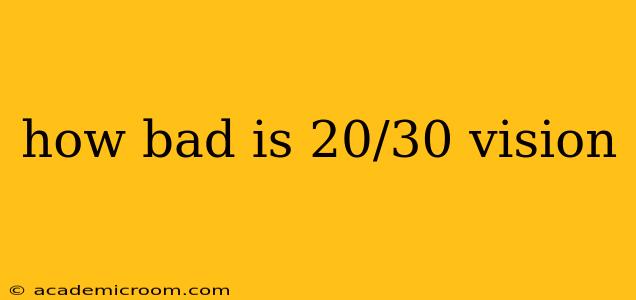Visual acuity, often expressed as a fraction like 20/30, is a measure of how clearly you see at a distance compared to a person with normal vision. Understanding what your vision score means is crucial for managing your eye health and making informed decisions about corrective lenses. So, how bad is 20/30 vision? Let's delve into the details.
What Does 20/30 Vision Mean?
The top number (20) represents the distance in feet at which you're standing from the eye chart. The bottom number (30) indicates the distance at which a person with normal vision (20/20) can read the same line. Therefore, 20/30 vision means you can see at 20 feet what a person with perfect vision can see at 30 feet. In simpler terms, you need to be closer to an object to see it as clearly as someone with 20/20 vision.
Is 20/30 Vision Considered Bad?
20/30 vision isn't considered legally blind, and many people with this visual acuity live full and productive lives without significant impairment. It falls within the range of mild to moderate visual impairment. However, it's important to note that the impact of 20/30 vision can vary from person to person, depending on individual needs and lifestyle.
How Does 20/30 Vision Affect Daily Life?
While often manageable, 20/30 vision might affect daily activities in the following ways:
- Driving: Driving at night or in low-light conditions can be more challenging, requiring extra caution.
- Watching TV or Movies: Sitting too far from the screen might be necessary to see details clearly.
- Reading: Reading small print, like menus or instructions, might require more effort and could lead to eye strain.
- Sports and Hobbies: Certain activities requiring sharp vision, like playing sports or detailed crafts, may be more difficult.
What Causes 20/30 Vision?
Several factors can contribute to 20/30 vision, including:
- Refractive Errors: Myopia (nearsightedness), hyperopia (farsightedness), and astigmatism are common causes. These conditions often result from the shape of the eye or how light focuses on the retina.
- Age-Related Changes: Presbyopia, a gradual loss of focusing ability with age, often affects individuals over 40.
- Underlying Medical Conditions: Certain medical conditions can impact vision, so it's important to consult an eye doctor for a thorough examination if you experience a sudden change in vision.
Can 20/30 Vision Be Corrected?
Yes, 20/30 vision is usually correctable with eyeglasses, contact lenses, or refractive surgery. The appropriate corrective method depends on the underlying cause of the vision impairment and individual preferences. An optometrist or ophthalmologist can perform a comprehensive eye exam to determine the best course of action.
How Often Should I Get My Eyes Examined?
Regular eye exams are crucial for maintaining good eye health, even if you currently don't experience any vision problems. The frequency of exams depends on your age and individual risk factors, but generally, adults should have a comprehensive eye exam at least every two years.
What are the different levels of vision impairment?
Visual impairment is classified in several ways, typically using the Snellen chart, which produces the familiar 20/X notation. 20/20 is considered normal vision, while 20/30 is mild to moderate. More severe impairments exist, leading to legal blindness. It's crucial to consult an eye care professional for a complete understanding of your visual acuity and its implications.
Is 20/30 vision considered legal blindness?
No, 20/30 vision is not considered legal blindness. Legal blindness is typically defined as a visual acuity of 20/200 or worse in the better eye with correction, or a field of vision of 20 degrees or less.
By understanding the implications of 20/30 vision and seeking professional eye care, individuals can effectively manage their visual health and maintain a high quality of life. Remember, regular eye exams are key to early detection and treatment of any vision problems.
